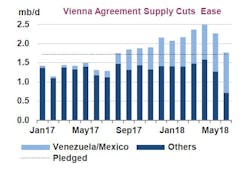The Organization of the Petroleum Exporting Countries, Russia, and several other producers recently agreed to increase their production and achieve 100% compliance with the Vienna Agreement. Such determination to ensure the steady supply of oil to world markets in the face of multiple challenges to stability is very welcome, according to the International Energy Agency.
However, as noted in IEA’s latest monthly report, the rising production from Middle East Gulf countries and Russia, welcome though it is, comes at the expense of the world’s spare capacity cushion, which might be stretched to the limit.
With the slimmed global spare capacity cushion, various supply concerns, although some of them are likely to be resolved, will become an even bigger issue, according to IEA. This vulnerability currently underpins oil prices and seems likely to continue doing so.
“We see no sign of higher production from elsewhere that might ease fears of market tightness,” IEA said.
Global oil supply
Global oil supply rose by 370,000 b/d to 98.8 million b/d in June as Saudi Arabia and Russia opened the taps ahead of a meeting between Vienna Agreement producers.
Output curbs by the 24 countries slipped to 1.8 million b/d in June, from 2.3 million b/d in May and a peak of 2.5 million b/d in April. Compliance for OPEC members eased to 120% in June, while non-OPEC slipped to 66%. This equates to an overall compliance of 100%, according to IEA estimates.
Russia boosted output by nearly 100,000 b/d in June and said it would add up to 200,000 b/d over the second half of 2018. Meantime, Saudi Arabia’s sharp increase in June allowed it to overtake the US and reclaim its position as the world’s second largest crude producer.
Despite higher output in June, OPEC oil supply was down 700,000 b/d compared to a year ago, with Venezuela lower by nearly 800,000 b/d, Angola by 210,000 b/d, and Libya by 130,000 b/d.
The biggest month-on-month decline came from Libya, which saw oil output drop by 260,000 b/d on average in June to 760,000 b/d due to renewed unrest. The situation appeared to be improving and Libya is poised to resume oil exports. The announcement of Libya’s National Oil Corp. on Wednesday appeared to signal an end to the tense standoff that had shut down most of the country’s oil supply. “However, it is unclear whether previous rates of around 1 million b/d can be reached immediately due to the destruction of several storage tanks at Ras Lanuf,” IEA said.
For the non-OPEC part, a prolonged outage at one of Canada’s upgraders from mid-June cut synthetic crude production by more than 300,000 b/d and temporarily restricted flows into Cushing. Heavy maintenance and unscheduled outages also curbed output in the North Sea, Brazil, Kazakhstan, and Angola over the May-June period.
Even so, global oil output was 1.25 million b/d higher than a year ago as rampant US output underpinned healthy non-OPEC growth. Non-OPEC supplies in June were 1.95 million b/d higher than a year earlier. For the year, non-OPEC output is expected to expand by nearly 2 million b/d before easing slightly to 1.8 million b/d in 2019, as US supply growth slows from 1.7 million b/d in 2018 to 1.2 million b/d next year. Along with an increased decline base, limited takeaway capacity, inflationary pressures and more disciplined spending are contributing to the slowdown in growth, according to IEA.
Demand
On the demand side, although there are emerging signs of reduced economic confidence, and consumers are unhappy at higher prices, IEA retains the view that growth in 2018 will be 1.4 million b/d, and about the same next year.
The economic forecast that underpins this report remains unchanged. World GDP growth is estimated to remain at 3.9% in 2019.
Risks remain elevated, however, IEA warned. Increasing trade tensions could have a direct negative impact on economic growth, bunker fuel demand, and diesel used by trucks for the transportation of traded goods. Tariffs could also affect the trade of oil and petrochemical feedstocks and products. Several countries are also feeling the pain of higher oil prices, particularly so when combined with currency depreciation versus the US dollar.
OECD Americas oil demand growth is expected to be robust in 2018, at around 340,000 b/d, supported by a very strong start to the year reflecting harsh weather conditions and the start-up of petrochemical projects in the US. More ethane crackers coming on stream should maintain OECD Americas oil demand growth at 155,000 b/d in 2019. Modest gains in OECD Europe should be roughly offset by similar declines in OECD Asia and Oceania. Overall, IEA expect OECD oil demand growth to slow from 340,000 b/d in 2018 to 165,000 b/d in 2019.
Non-OECD oil consumption is expected to increase by 1.05 million b/d in 2018, lower than the 1.17 million b/d seen in 2017 as rising prices limit demand. In 2019, a large part of the price impact should have been absorbed and non-OECD growth is set to accelerate to 1.21 million b/d, with Asia the largest contributor.


